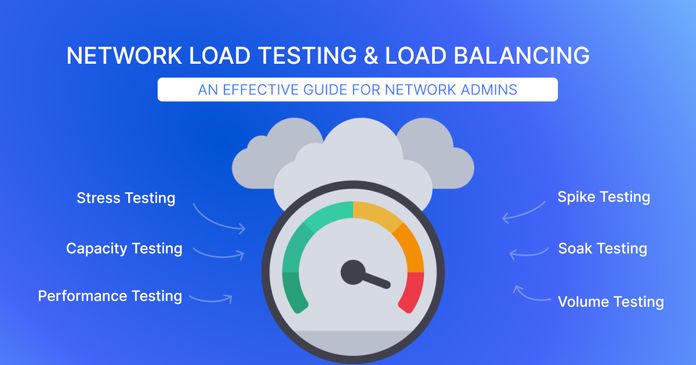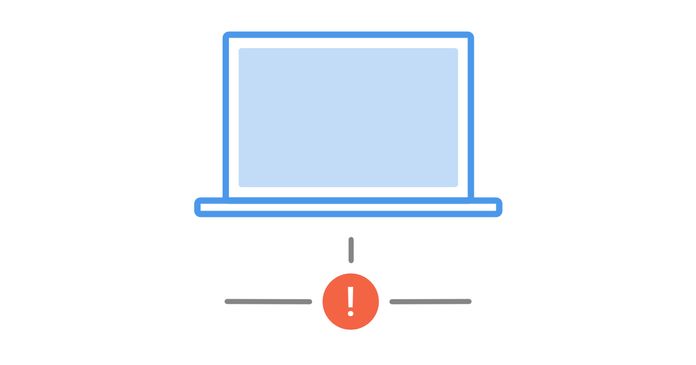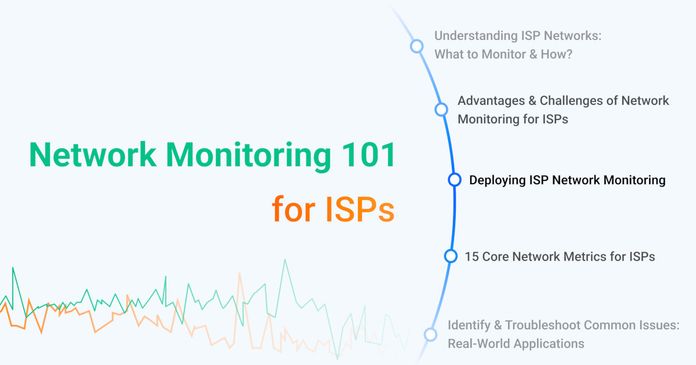Table of Contents
Table of Contents
Dual-WAN networks have become a go-to solution for businesses looking for enhanced reliability and network performance. With not one but two Internet connections and the safeguard of a firewall, Dual-WAN configurations offer a robust solution – if one connection fails, the other seamlessly takes over. But, it's not a matter of if one will fail, but rather when.
Whether you're a seasoned IT professional or delving into the intricacies of dual-wired wide-area networks (Dual-WAN) for the first time, it’s important to ensure that your dual-wan network is working as it should be.
This article goes beyond the basics, exploring advanced techniques and strategies to elevate your Dual-WAN monitoring game. As we navigate the complex landscape of network redundancy and load balancing, we'll uncover insights that go beyond the standard protocols, providing you with a comprehensive toolkit to ensure optimal performance and minimal downtime.
So, fasten your seatbelts as we delve into monitoring Dual-WAN, recognizing that in this landscape, it's not a question of if one connection will fail, but rather when.
Dual-WAN networks, short for Dual Wide Area Networks, fundamentally operate on the principle of diversifying Internet connectivity. In a typical setup, two separate Internet connections are integrated, often from different service providers or utilizing distinct technologies. This setup introduces an additional layer of reliability, allowing the network to seamlessly switch between connections in the event of a failure.
Dual-WAN networks are extremely beneficial for businesses aiming to fortify their connectivity. Unlike traditional setups reliant on a single internet connection, Dual-WAN configurations bring redundancy to the forefront, incorporating two independent links to ensure uninterrupted access to online resources. This redundancy is not merely a convenience; it is a critical component of network resilience, providing a safety net in the event of connection failures.
The reliability of a Dual-WAN network is contingent upon effective monitoring. Network Performance Monitoring plays a pivotal role in ensuring that both Internet connections are operating optimally, distributing traffic appropriately, and responding promptly to any anomalies. Without robust monitoring practices in place, the benefits of redundancy can be compromised, leading to potential downtime and service disruptions.
In the world of networking, failures are not a matter of "if" but "when." Recognizing the inevitability of failures becomes a guiding principle in the design and management of Dual-WAN networks. Whether due to infrastructure issues, service provider outages, or unexpected events, understanding that failures are part of the operational landscape emphasizes the critical need for proactive monitoring and contingency planning.
As we delve into the intricacies of Dual-WAN monitoring, it's crucial to approach the subject with the mindset that anticipates and mitigates failures, ensuring a robust and reliable network infrastructure. Join us on this journey beyond the basics as we explore advanced techniques to elevate your Dual-WAN monitoring capabilities.
To effectively monitor and manage Dual-WAN networks, it's essential to grasp the intricacies of their architecture, the role of firewalls, and the principles behind redundancy and load balancing.
Dual-WAN architecture involves the integration of two distinct wide-area networks into a single network infrastructure. This configuration is designed to enhance reliability and minimize the impact of network failures. Each WAN connection operates independently, and the system is configured to intelligently switch between the two in response to changing network conditions. This architecture not only provides failover capabilities but also allows for efficient load distribution, ensuring optimal utilization of available bandwidth.
Understanding the nuances of Dual-WAN architecture includes familiarity with failover mechanisms, where the system automatically redirects traffic from a failed connection to a working one. Additionally, load balancing plays a crucial role in distributing network traffic evenly across both connections, preventing bottlenecks and optimizing overall network performance.
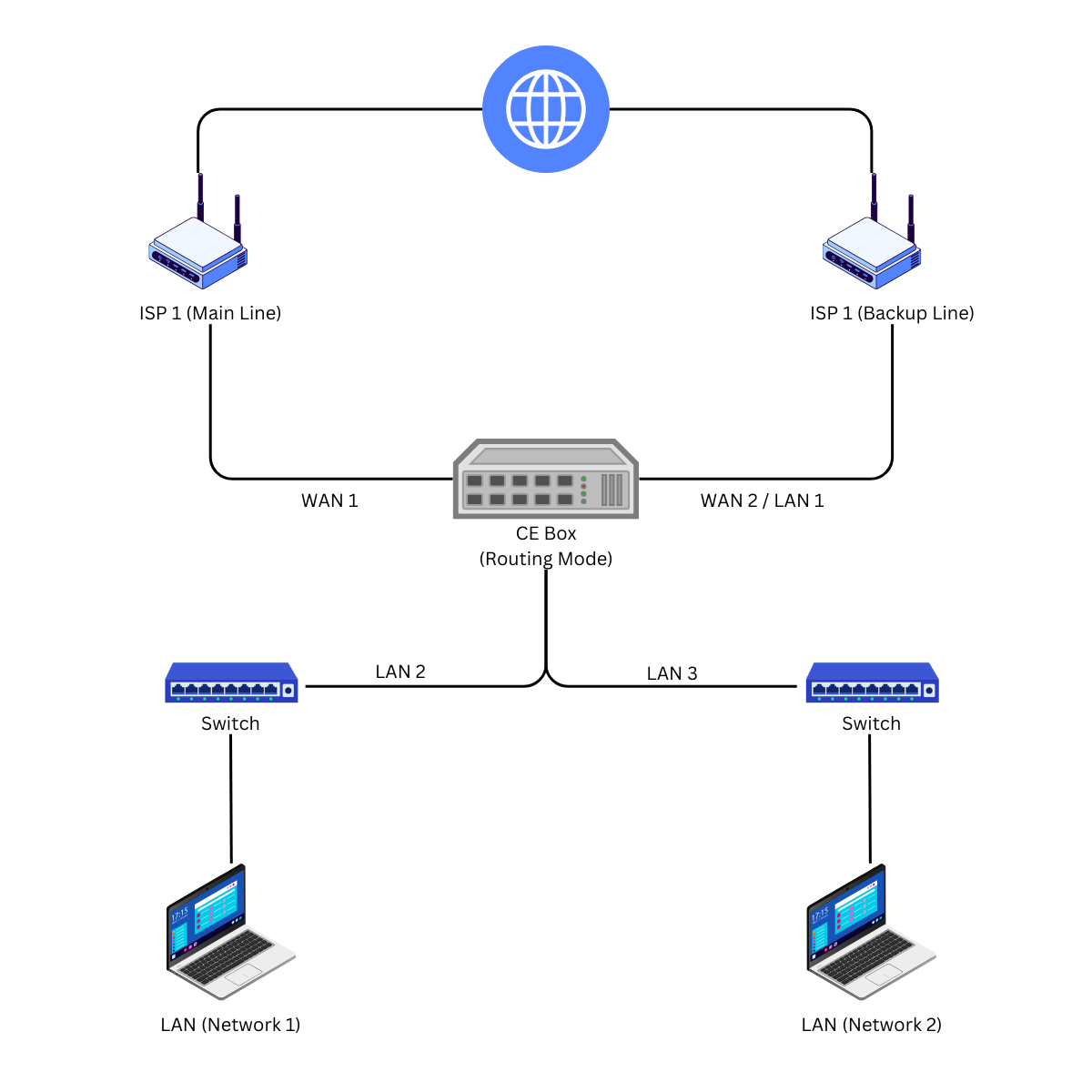

Dual-WAN (Wide Area Network) is a networking configuration that involves the use of two separate Internet connections to enhance reliability, load balancing, and failover capabilities. Let’s dive into the details of how Dual-WAN typically works:
- Multiple WAN Connections: In a Dual-WAN setup, there are two or more distinct Wide Area Network connections. These connections can be from different Internet Service Providers (ISPs) or utilize diverse technologies such as DSL, cable, fibre, or wireless.
- Load Balancing: One of the key functionalities of Dual-WAN is load balancing. Load balancing evenly distributes network traffic across the available WAN connections. This optimization ensures that the overall bandwidth is utilized efficiently, preventing one connection from becoming a bottleneck.
- Failover Mechanism: Dual-WAN configurations often include a network failover mechanism. If one of the WAN connections fails or experiences issues, the system automatically redirects traffic to the operational connection(s). This failover ensures uninterrupted connectivity even if one of the internet links encounters problems.
- Redundancy: Dual-WAN provides redundancy by having multiple internet connections. If one connection becomes unavailable, the network can seamlessly switch to an alternative connection, minimizing downtime and ensuring continuous service availability.
- Routing Decisions: The Dual-WAN router or gateway makes intelligent routing decisions based on predefined rules or algorithms. These decisions take into account factors such as current link status, bandwidth availability, latency, and other performance metrics.
In the context of Dual-WAN networks, firewalls serve as the guardians of network security. Beyond their traditional role of filtering and monitoring incoming and outgoing traffic, firewalls in Dual-WAN setups are integral to managing and controlling the flow of data across multiple connections. They enforce security policies, prevent unauthorized access, and contribute to the overall stability of the network.
Firewalls play a vital role in ensuring that the failover and load-balancing mechanisms operate securely. They facilitate the secure transition of traffic between the two WAN connections and protect against potential vulnerabilities that may arise during the switchover process. Understanding how firewalls interact with Dual-WAN setups is paramount for maintaining a secure and reliable network environment.
At the heart of Dual-WAN networks are the principles of redundancy and load balancing.
Redundancy, as mentioned earlier, involves the use of two separate Internet connections to ensure continuous connectivity. When one connection experiences a failure, traffic is automatically redirected to the backup connection, minimizing downtime.
Load balancing, on the other hand, is the intelligent distribution of network traffic across both connections to optimize bandwidth utilization. This not only enhances performance but also prevents one connection from becoming overloaded while the other remains underutilized. Striking the right balance between redundancy and load balancing is crucial for achieving both reliability and efficiency in Dual-WAN environments.
As we proceed through this exploration beyond the basics, we'll delve into advanced monitoring techniques that leverage a deep understanding of Dual-WAN architecture, firewalls, and the delicate balance between redundancy and load balancing. Join us as we uncover the keys to mastering Dual-WAN monitoring and management.
Explore the world of network administration with insights on network load testing, network load balancing, and the role of NPM. Optimize your network today!
Learn more

Many businesses face a lack of visibility into their Dual-WAN networks. While vendors often make bold claims about the monitoring capabilities of their Dual-WAN solutions, the reality is that most fall short of providing the necessary depth and visibility required for monitoring contemporary Dual-WAN setups.
In practical terms, a significant 75% of IT professionals encounter considerable challenges with the native monitoring features embedded in their Dual-WAN services.
Moreover, the scarcity of monitoring tools capable of genuinely assessing Dual-WAN network performance from the user perspective poses a critical challenge. Understanding whether your Dual-WAN service lives up to its promises becomes crucial.

Monitoring Dual-WAN networks provides several advantages, contributing to improved reliability, performance, and overall network health.
- *[Network Failover Monitoring](/blog/monitor-network-failover/: By continuously monitoring both WAN connections, any potential failures or disruptions can be detected in real-time. This allows for swift failover to the backup connection, minimizing downtime and ensuring uninterrupted connectivity.
- Early Detection of Anomalies: Monitoring tools can identify abnormal network behaviour or performance issues before they escalate into critical problems. This proactive approach enables IT professionals to address issues swiftly, reducing the impact on users and operations.
- Load Balancing Optimization: Monitoring tools help in balancing network traffic between the two WAN connections efficiently. This ensures optimal utilization of available bandwidth, preventing congestion on one link while leaving the other underutilized.
- Optimized Bandwidth Utilization: Effective monitoring allows for better management of bandwidth, preventing unnecessary expenses on overprovisioning. By understanding the actual usage patterns, organizations can make informed decisions about their bandwidth requirements.
- End-to-End Performance Monitoring: Monitoring tools provide insights into the end-to-end performance of applications and services. This helps ensure a consistent and reliable user experience, especially in scenarios where applications span multiple locations or use diverse network paths.
- Verification of Service Level Agreements (SLAs): Monitoring tools empower organizations to verify whether service providers are meeting the terms outlined in SLAs. This ensures accountability and provides grounds for negotiation or action if service standards are not met.
This brings us to the imperative need for modern decentralized network monitoring solutions, such as Obkio, to step in and address these gaps. In the following sections, we'll guide you through the process of monitoring Dual-WAN network performance using advanced tools like Obkio.
To monitor Dual-WAN networks, you need a modern solution that monitors end-to-end network performance to identify network problems before and after your Dual-WAN network is in place. Traditional monitoring solutions that focus on your device won’t give you real insight into your network’s performance.
A tool like Obkio Network Performance Monitoring software continuously monitors end-to-end network performance with synthetic traffic using Network Monitoring Agents.

- Monitoring Sessions measure network performance between any two points in your network.
- Performance Metrics provide vital data on the health of your network.
- Dynamic Thresholds trigger network monitoring alerts for latency, jitter, packet loss, packet reordering & packet duplication, and MOS score.
- Proactive Alerts identify events that affect network quality before they affect end-user experience.
- Smart Notifications reduce notification overload and emphasize important events.
Obkio’s Network Monitoring Agents are software deployed in key network locations to monitor your Dual-WAN network locations and Internet performance, measure network metrics (latency, jitter, packet loss), and alert you about Dual-WAN performance issues in your network.
They create Monitoring Sessions and use synthetic UDP traffic for decentralized network monitoring from the source (your computer or your office) up to the destination (another office, data center or clouds).
To achieve the level of depth required to monitor Dual-WAN networks, install Network Monitoring Agents to measure Dual-WAN network performance like an end-user.
You need:
- Local Agents: Installed in the targeted locations you want to monitor. There are several Agent types available (all with the same features), and they can be installed on MacOS, Windows, Linux and more.
- Public Monitoring Agent: These are deployed over the Internet and managed by Obkio. They compare performance up to the Internet and quickly identify if the network issue is global or specific to the destination. For example, measure network performance between your head office and your firewall.
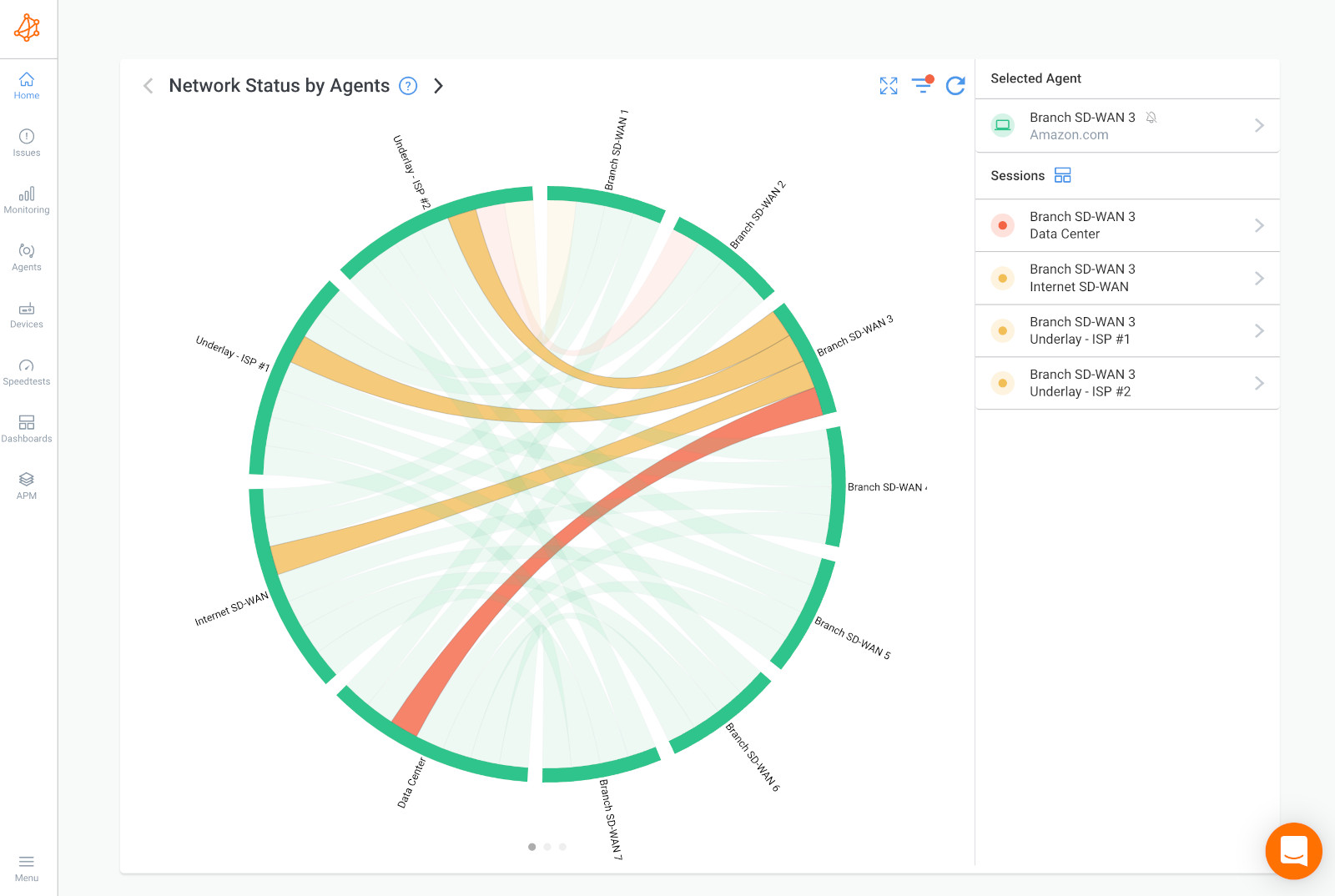
The Agents then create Monitoring Sessions by exchanging synthetic UDP packets between every 2 sets of Agents to measure performance metrics and raise alerts for when network issues are detected.
When you’re planning out where to install your Monitoring Agents, it’s important to understand what you should be monitoring. A Dual-WAN network is made of various locations, connections, devices, and so on - so there’s a lot to keep in mind.
- WAN Interfaces: Check the status of each WAN connection to ensure they are active and operational. Monitor the status, bandwidth, and health of each individual WAN interface.
- Link Uptime and Downtime: Monitor the uptime and downtime of each WAN link to identify any patterns or trends in connection stability.
- Firewall Performance: Monitor the performance of firewalls on both ends of the Dual-WAN setup to ensure security and efficient traffic management.
- Load Balancer: Keep an eye on the load balancer to ensure it distributes traffic evenly across the multiple WAN connections.
- Failover Mechanism: Monitor the failover mechanism to ensure a smooth transition in the event of a WAN connection failure.
- Routers: Monitor the routers connected to each WAN link to ensure they are operating efficiently and without issues.
- Switches: Monitor switches within the network to ensure proper connectivity and performance.
- VPN Devices: If Virtual Private Networks (VPNs) are used, monitor the devices responsible for VPN connections.
- Gateway Device: Monitor the Dual-WAN gateway device, which is responsible for managing traffic between the LAN and WAN connections.
- Modems or Network Interface Cards (NICs): Monitor the hardware components responsible for connecting the Dual-WAN setup to the Internet.
- Network Paths: Monitor the different paths that traffic can take between the Dual-WAN setup and external networks.
- User Endpoints: Implement end-to-end monitoring to assess the actual user experience and identify any issues affecting endpoints.
By monitoring these specific parts of the Dual-WAN network, you can gain insights into its overall health, quickly identify issues, and ensure that all components work together seamlessly to provide reliable and efficient connectivity.
Monitoring the performance of a Dual-WAN network from both the end-user perspective and the underlying connections is crucial for obtaining a comprehensive understanding of its functionality and ensuring it aligns with service level agreements (SLAs) or promises made.
The user experience in a Dual-WAN network refers to how end-users perceive and interact with applications and services. It encompasses factors such as application responsiveness, load times, and overall satisfaction. Monitoring the user experience provides valuable insights into the real-world performance of the network from the perspective of the individuals relying on it.
Application Performance: By monitoring the end-user perspective, you gain insights into how applications and services perform from the user's viewpoint. This includes assessing factors like application responsiveness, load times, and overall user satisfaction.
Quality of Service (QoS): Understanding the end-user perspective allows you to evaluate QoS metrics, ensuring that critical applications receive the necessary priority and bandwidth for a seamless experience.
Reliability and Accessibility: End-user monitoring provides real-world data on the reliability and accessibility of services. This is especially important for businesses relying on Dual-WAN networks to deliver consistent and dependable connectivity to their users.
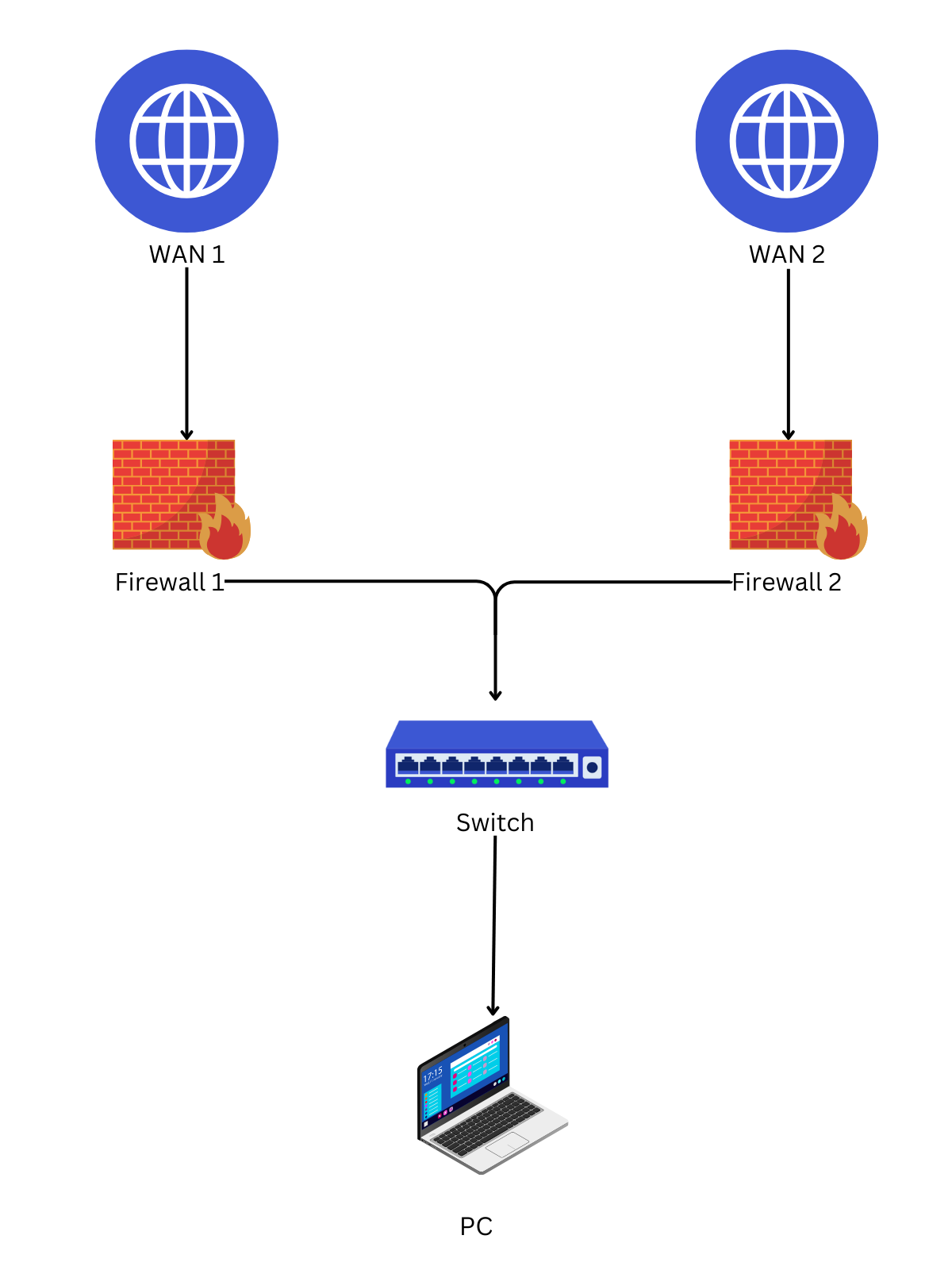
Underlay connections in a Dual-WAN network represent the foundational links that form the backbone of the network infrastructure. These connections include the individual Wide Area Network (WAN) links, each serving as a pathway for data transmission.
1. WAN Link Performance:
Monitoring underlay connections involves assessing the performance metrics of each WAN link, including bandwidth utilization, latency, packet loss, and failover effectiveness. Lucky for you, Obkio will automatically monitor these network metrics for you!
- Bandwidth Utilization: Monitoring the individual WAN connections allows you to assess how well they are utilizing available bandwidth. This information is critical for optimizing load balancing and ensuring efficient traffic distribution.
- Latency and Packet Loss: Examining the performance metrics of each WAN link helps identify issues such as high latency or packet loss, which can impact the overall network performance.
2. Failover and Redundancy:
Monitoring the underlay connections ensures that failover mechanisms are functioning as expected. This includes testing the switchover process to guarantee seamless transitions in the event of a connection failure.
Regularly assessing the redundancy of the Dual-WAN setup ensures that there are no single points of failure. It verifies that the network can maintain connectivity even if one of the links experiences problems.
3. SLA Adherence:
Monitoring both the end-user perspective and the underlay connections is integral to verifying whether the Dual-WAN network is meeting the terms outlined in SLAs or service promises. It establishes accountability and ensures that the network is delivering as expected.
Monitoring the device performance in a Dual-WAN setup is crucial for maintaining the security, availability, and efficient traffic management of the network. That’s why we always recommend deploying Monitoring Agents to monitor network devices.
You can also use Obkio’s Network Device Monitoring feature to monitor devices like firewalls, routers and switches using SNMP.
Firewalls in a Dual-WAN network serve as critical gatekeepers, enforcing security policies and regulating traffic flow between the Local Area Network (LAN) and multiple Wide Area Network (WAN) connections.
- Firewall Performance Metrics: Monitoring the overall performance of the firewall includes assessing resource utilization such as CPU, memory usage, response times for rule processing, and latency introduced by the firewall. Understanding the hardware's capabilities ensures that the firewall can handle the network's demands.
- Load Balancing and Redundancy: In a Dual-WAN setup, firewalls often contribute to load balancing by distributing traffic across multiple WAN connections. Monitoring load balancing ensures an equitable distribution of network load, optimizing the utilization of available bandwidth.
- VPN Performance: If Virtual Private Networks (VPNs) are implemented for secure communication, monitoring firewall performance includes assessing the efficiency and reliability of VPN connections.
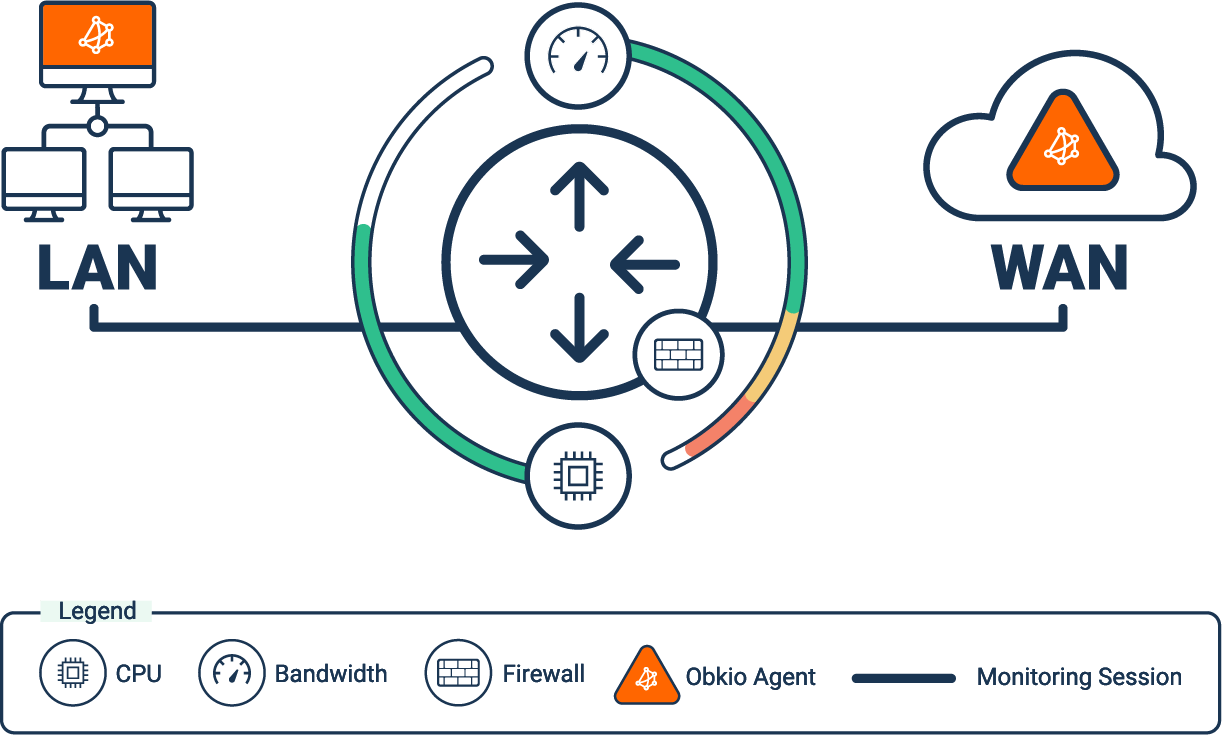
When it comes to Dual-WAN networks, Firewalls aren’t the only network devices you should be keeping an eye on. Dual-WAN routers are also key to Dual-WAN performance and need to be monitored for performance and availability.
Dual-WAN routers are responsible for managing the connectivity between the local area network (LAN) and multiple wide area networks (WANs). Monitoring these routers ensures their uptime and availability. Downtime in a Dual-WAN setup can lead to service interruptions. Monitoring routers helps detect and address issues promptly, minimizing downtime and maintaining continuous connectivity.
- Load Balancing and Failover:
Dual-WAN routers often handle load balancing and failover mechanisms. Monitoring ensures these features work as intended, distributing traffic efficiently and seamlessly switching to backup connections when necessary. Efficient load balancing optimizes network performance, while effective failover mechanisms enhance reliability by mitigating the impact of connection failures.
- Bandwidth Management:
Monitoring routers allows tracking of bandwidth utilization on each WAN link. This information is vital for optimizing traffic flow and ensuring that bandwidth resources are used effectively. Understanding bandwidth usage patterns helps in network capacity planning and prevents bottlenecks, ensuring a consistent user experience.
- Routing Protocols:
Dual-WAN routers use routing protocols to determine the best path for data transmission. Monitoring these protocols ensures the router is making optimal routing decisions. Effective routing is crucial for efficient data transmission. Monitoring helps identify any issues with routing protocols that may impact network performance.
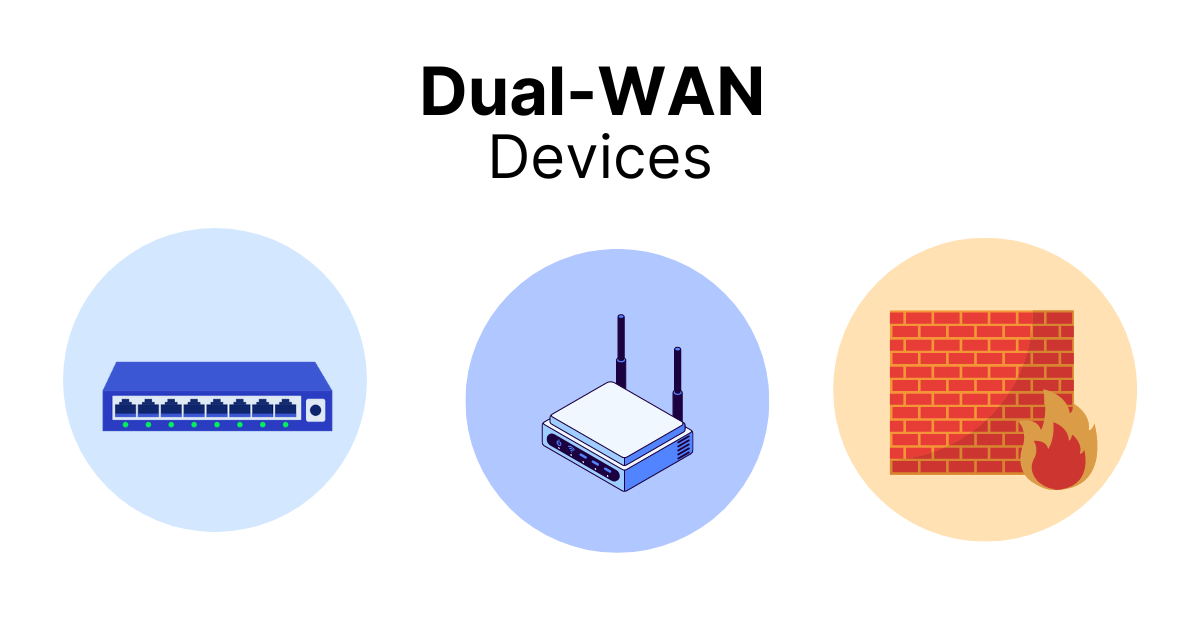
A big part of monitoring Dual-WAN is collecting a variety of data about the performance of different aspects of your Dual-WAN network. So far, we’ve talked about what parts of your network to monitor and how, but now we’re going to dive a little deeper into the different types of data you should be looking at.
When monitoring a Dual-WAN network, various performance metrics provide insights into its health, efficiency, and reliability. If you’re using an end-to-end Network Monitoring tool here, like Obkio, you don’t need to worry about measuring them yourself because Obkio will do it for you. Your Network Monitoring tool will also help you interpret the metrics and alert you if there are any issues.
Regardless, it’s still important to understand what network performance metrics to look at:
- WAN Link Utilization: Measures how much of the available bandwidth on each WAN link is being used. Identifying peak usage helps in optimizing load balancing and ensures efficient utilization of both WAN connections.
- Latency: Measures the delay between sending and receiving data packets. Low latency is crucial for real-time applications, and monitoring it helps ensure responsive and smooth communication.
- Packet Loss: Tracks the percentage of data packets lost during transmission. High packet loss can degrade application performance and user experience; monitoring helps identify and address issues.
- Jitter: Measures the variation in latency over time. Consistent jitter is essential for real-time applications like VoIP. Monitoring helps ensure stable communication quality.
- Load Balancing Effectiveness: Evaluates how evenly traffic is distributed across both WAN connections. Effective load balancing optimizes bandwidth utilization and prevents congestion on a single link.
- Failover and Failback Performance: Assesses the time it takes for the network to switch to a backup connection and return to the primary one. Efficient failover and failback processes minimize network downtime in case of WAN link failures.
- Quality of Service (QoS) Metrics: Measures the effectiveness of QoS policies in prioritizing specific types of traffic. Ensures critical applications receive the necessary priority, preventing degradation of service quality.
- Throughput: Measures the actual data transfer rate between the Dual-WAN network and external servers. Monitoring throughput helps assess the overall network performance and identify potential bottlenecks.
- Bandwidth Usage Patterns: Analyzes how bandwidth is utilized over time and during peak hours. Understanding usage patterns aids in capacity planning and ensures sufficient bandwidth for critical operations.
- Firewall Performance Metrics: Includes metrics such as CPU usage, memory utilization, and the number of sessions. Monitors the health and efficiency of the firewall, ensuring it can handle the network's security requirements.
- VPN Performance: Evaluates the performance of VPN connections, including latency and throughput. Ensures secure and reliable communication for remote offices or users connected via VPN.
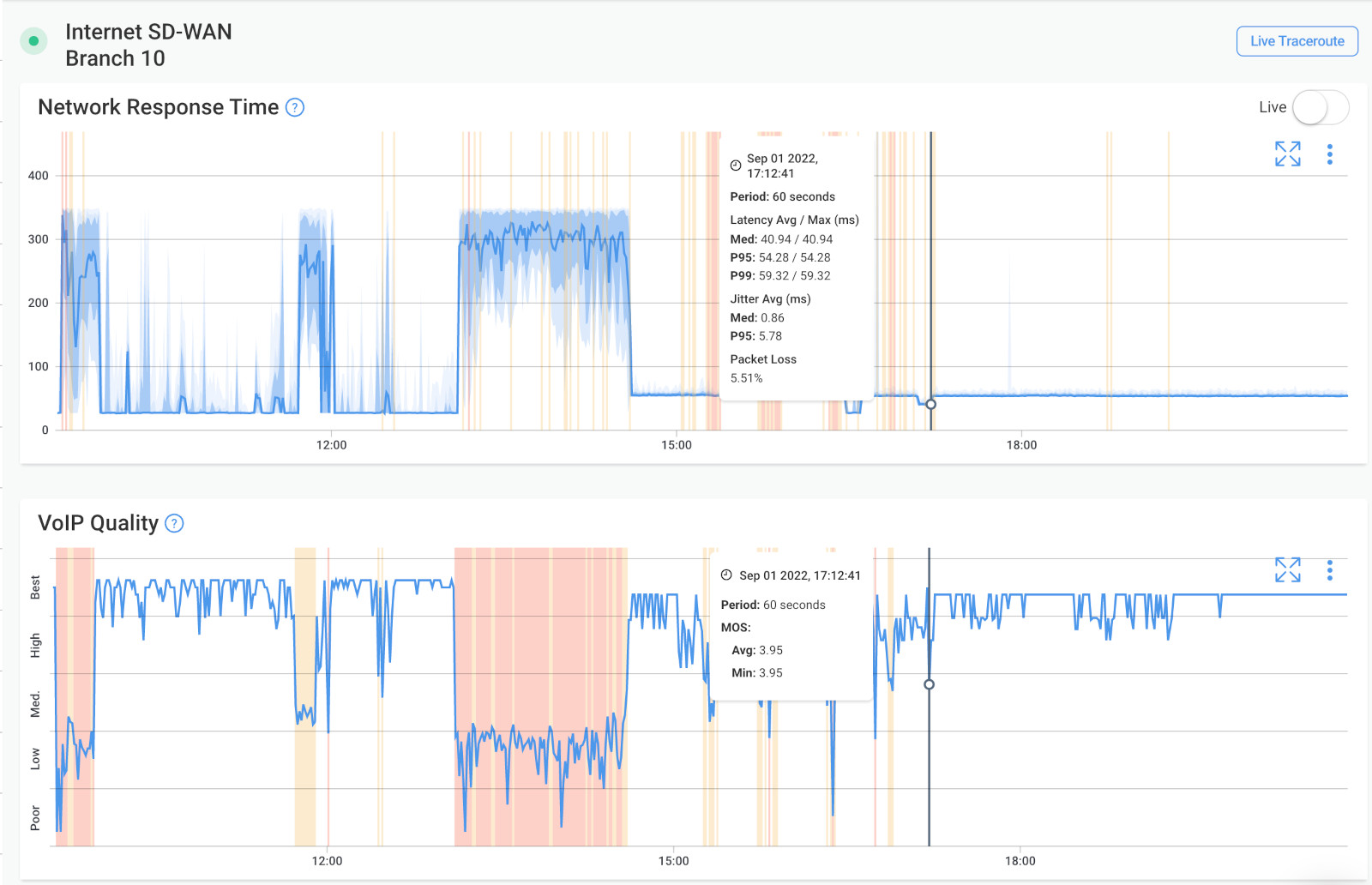
Historical data is crucial for understanding the long-term performance trends of a Dual-WAN network. It enables insightful trend analysis, helping administrators make informed decisions regarding capacity planning, configuration optimizations, and issue prediction. Establishing network performance baselines through historical data aids in identifying anomalies and deviations, facilitating effective root cause analysis during troubleshooting. Additionally, historical data serves as a valuable reference for compliance reporting, audits, and documentation, ensuring adherence to industry standards over time.
For organizations with strategic plans or long-term projects, historical data plays a vital role in evaluating the impact of optimizations and changes made to the Dual-WAN network. It assists in aligning network capabilities with future requirements and serves as a record of network evolution.
Alerts are instrumental in providing real-time notifications about critical events in a Dual-WAN network. They serve as a proactive warning system, allowing administrators to detect and address potential issues before they escalate. Immediate responses to critical events, such as WAN link failures or security breaches, are facilitated through alert notifications. Customizable thresholds in alerts enable organizations to tailor notifications based on specific requirements, ensuring meaningful and actionable information.
Furthermore, alerts contribute to the adherence to Service Level Agreements (SLAs) by promptly notifying administrators when performance metrics deviate from agreed-upon standards. Security-related alerts play a crucial role in incident response, offering rapid detection and response to potential threats. Integrating alerts into automated notification workflows streamlines incident response processes, ensuring that the right personnel are notified promptly and facilitating efficient collaboration among team members.


You can now use all the data you’ve collected to identify network problems related to your Dual-WAN network and collect the information you’ll use to troubleshoot. Built a custom dashboard to include graphs and performance data for all your Dual-WAN network locations, devices, applications and services.
Analyze the information Obkio collects related to your Dual-WAN network performance to identify:
- What the problem is
- Where the problem is located
- What caused the problem
- When the problem happened
- Who is responsible for the network segment
Several common performance issues can arise in Dual-WAN networks, impacting reliability, speed, and overall functionality. Here are some of the common Dual-WAN performance issues that you may encounter:
- Uneven Load Balancing: Ineffective load balancing can lead to uneven distribution of traffic across multiple WAN connections. Suboptimal load balancing can result in underutilization of one connection and congestion on another, leading to performance degradation.
- Inefficient Failover: Failover mechanisms that do not activate swiftly or fail to revert promptly to the primary connection can lead to downtime. Inefficient failover can disrupt services, affecting critical applications and causing service interruptions for end-users.
- Bandwidth Saturation: Network congestion occurs when the available bandwidth is insufficient to handle the volume of traffic. Saturation can lead to slow network speeds, increased latency, and degraded performance for applications, especially during peak usage periods.
- Routing Inefficiencies: Inefficient routing decisions by the Dual-WAN router can result in suboptimal data transmission paths. Poor routing choices may lead to increased latency and packet loss, affecting the overall performance and responsiveness of the network.
- Application Performance Issues: Certain applications may experience performance issues if not properly prioritized through Quality of Service (QoS) settings. Critical applications may suffer from latency or packet loss, impacting the user experience and causing delays in data transmission.
- DNS Resolution Problems: Delays or failures in Domain Name System (DNS) resolution can result in slow access to websites and online resources. Users may experience delays in accessing web services, affecting productivity and user satisfaction.
- Incorrect Configuration: Misconfigurations in the Dual-WAN setup, firewall rules, or routing tables can lead to unexpected performance issues. Incorrect configurations can result in network instability, disruptions, and vulnerabilities that may be exploited by malicious actors.
- Hardware Limitations: Outdated or underpowered hardware may not effectively support the demands of a Dual-WAN network. Hardware limitations can lead to bottlenecks, reducing the overall performance and responsiveness of the network.
Addressing network issues in Dual-WAN networks requires a proactive approach, including regular monitoring, optimization of configurations, and timely troubleshooting and updates. Your Network Monitoring tool will help with all this!
Learn how to identify network issues by looking at common problems, causes, consequences and solutions.
Learn more

When you’re monitoring your Dual-WAN network, you’re bound to come across a failure at some point.
Dual-WAN failures refer to situations where a Dual-WAN setup encounters issues that result in the disruption or degradation of network connectivity. In a Dual-WAN configuration, the network relies on multiple WAN connections simultaneously to enhance reliability, load balancing, and failover capabilities. Failures can occur at various levels of the Dual-WAN network, affecting its ability to function optimally.
WAN Link Failures: One or more of the physical or logical connections to the external networks (WAN links) experience a disruption or failure. This can lead to a loss of connectivity through a specific link, potentially leading to decreased overall network performance.
Load Balancing Issues: Load balancing, responsible for distributing traffic across multiple WAN links, may encounter configuration errors or inefficiencies. This can lead to an uneven distribution of traffic, suboptimal use of available bandwidth, and potential network congestion.
Failover Mechanism Failures: Failover mechanisms, designed to redirect traffic to an alternate WAN link in case of a primary link failure, may not activate or function as intended. This can lead to extended downtime or service interruptions when a primary link fails, as failover mechanisms do not seamlessly transition to the backup link.
Routing Issues: Incorrect routing decisions by the Dual-WAN router can lead to suboptimal data transmission paths. This can lead to increased latency, packet loss, or disruptions in communication due to inefficient routing.
Failback Issues: Failback procedures, designed to return traffic to the primary WAN link after a failure is resolved, may experience delays or inefficiencies. This can lead to prolonged suboptimal performance and reduced efficiency if failback processes are not swift and seamless.
Hardware Limitations: Outdated or underpowered hardware may struggle to support the demands of the Dual-WAN network. This can lead to network bottlenecks and reduced overall performance due to hardware limitations.


To maintain a reliable Dual-WAN network, you need to identify potential issues before they impact operations and users. Now that we know what Dual-WAN failures to look out for, let’s look into some key strategies and best practices to avoid them. These practices are essential for creating a resilient and high-performing network environment. Let's delve into the proactive measures that can safeguard your Dual-WAN setup and enhance overall network reliability.
An essential component of proactive network management in a Dual-WAN setup involves the implementation of comprehensive network monitoring tools. These tools are designed to continuously track and assess key performance metrics, providing real-time insights into the health and functionality of the Dual-WAN network.
We already talked about implementing Obkio’s Network Monitoring tool earlier on in this article, so, what are you waiting for? Networks may be complex. But Obkio makes network monitoring easy. Monitor, measure, pinpoint, troubleshoot, and solve network problems.

- 14-day free trial of all premium features
- Deploy in just 10 minutes
- Monitor performance in all key network locations
- Measure real-time network metrics
- Identify and troubleshoot live network problems
Continuous monitoring acts as a vigilant guardian for the Dual-WAN network, allowing for quick identification of performance bottlenecks, connectivity issues, or deviations from optimal configurations.
The primary purpose of continuous monitoring is to proactively track key performance metrics, including link status, bandwidth utilization, latency, and packet loss. By continuously analyzing these metrics, network administrators can swiftly detect abnormalities or signs of potential issues before they escalate.

Failover and failback procedures are critical components of Dual-WAN network management, ensuring seamless transitions during connection failures and efficient restoration.
- Failover Testing: Regularly test failover mechanisms to ensure they activate as intended during simulated failures. Testing helps identify any potential issues with failover configurations and ensures readiness for real-world scenarios.
- Failback Optimization: Optimize failback procedures to minimize the time taken to return to the primary connection after a failure is resolved. Quick failback ensures minimal disruption and optimal use of the primary WAN link once it becomes available again.
To ensure a resilient Dual-WAN network, one foundational strategy is incorporating diverse Internet Service Providers (ISPs) for each WAN connection. This involves establishing multiple connections with different ISPs, ensuring that each connection operates independently of the others.
The primary purpose of this strategy is to mitigate the risk of simultaneous failures across all WAN connections. By diversifying ISPs, the network becomes less susceptible to issues that might affect a single provider, such as infrastructure outages, maintenance, or regional disruptions. Redundant connections from distinct providers contribute to the overall resilience of the network, enabling it to maintain functionality even when faced with challenges in one or more ISP connections.
This approach ensures that the Dual-WAN network remains operational, providing continuous service to users and minimizing disruptions. Redundancy through diverse ISPs is a fundamental step towards fortifying the network against potential failures and enhancing its ability to deliver reliable and consistent connectivity.
Discover what and how to monitor with the right tool, setting the stage for top ISP network performance and a strong foundation for business growth.
Learn more

An integral aspect of maintaining an efficient Dual-WAN network is the ongoing review and optimization of load-balancing configurations. Load balancing distributes network traffic across multiple WAN links, preventing congestion on any single connection and optimizing the use of available bandwidth.
Regular reviews involve assessing the effectiveness of load-balancing algorithms, adjusting thresholds, and ensuring that the distribution of traffic aligns with the current network demands.
The primary purpose of load balancing optimization is to achieve an even distribution of network traffic across all available WAN links. This balanced distribution helps prevent the overutilization of one link, ensuring that each connection contributes optimally to the overall network performance. By avoiding uneven loads on individual links, organizations can maximize the utilization of their bandwidth resources, mitigate congestion, and enhance the responsiveness of the Dual-WAN network.
A crucial strategy for optimizing the performance of a Dual-WAN network involves configuring Quality of Service (QoS) settings. QoS allows network administrators to prioritize certain types of traffic over others based on their importance and sensitivity to delays. This involves classifying applications and services into different priority levels and assigning appropriate bandwidth allocations.
The primary purpose of QoS configuration is to ensure that essential traffic—such as data associated with critical applications and services—receives the necessary priority, especially during periods of high network activity. By assigning priority levels, QoS prevents degradation in service quality for crucial applications, ensuring they maintain optimal performance even when the network is under heavy load.
And there you have it! Now you know how to monitor and troubleshoot Dual-WAN networks to identify failures and performance issues so you can always ensure that your Dual-WAN setup is working as it should be.
Before we end up, let’s look into ways to optimize your Dual-WAN network!
Alright, now that you've got a handle on monitoring and troubleshooting Dual-WAN networks, it's time to dive into the fun stuff – optimization! Think of it as giving your network a bit of a boost. In this section, we explore best practices aimed at fine-tuning your Dual-WAN setup for peak performance.
Let’s dive into the key practices to optimize the performance of a Dual-WAN network:
- Continuous Monitoring: Keep your network monitoring tool as a permanent part of your tech stack. Use Obkio to monitor key performance metrics, such as link status, bandwidth utilization, latency, and packet loss, to detect issues proactively and facilitate rapid response.
- Load Balancing Configuration: Regularly review and fine-tune load balancing configurations to ensure an even distribution of traffic across all WAN links, preventing overutilization of one link and optimizing overall network performance.
- Quality of Service (QoS) Settings: Configure QoS settings to prioritize critical applications and services to ensure that essential traffic receives the necessary priority, preventing degradation in service quality during periods of high network activity.
- Failover Testing: Conduct regular failover tests under controlled conditions to verify that failover mechanisms activate as intended, ensuring a seamless transition to backup links during simulated failures.
- Regular Configuration Audits: Conduct periodic audits of router, firewall, and load balancing configurations to identify and address any misconfigurations that could lead to failures or suboptimal performance.
- Bandwidth Management: Manage bandwidth effectively with policies and traffic shaping to prevent bandwidth hogging, prioritize critical traffic, and ensure a balanced distribution of resources.
By implementing these optimization strategies, businesses can fine-tune their Dual-WAN setups to deliver reliable, high-performance connectivity that meets the demands of modern network environments. Now, let’s look into one more tip.

In a traditional Dual-WAN setup, failover mechanisms have long been employed as a safety net to ensure continued connectivity in the event of a single Internet connection failure. However, the landscape has evolved, and the demand for more sophisticated and efficient failover solutions has grown.
This is where SD-WAN (Software-Defined Wide Area Networking) comes in to revolutionize how we manage dual-wan scenarios. So when you’re looking to optimize Dual-WAN performance, SD-WAN may be the answer.
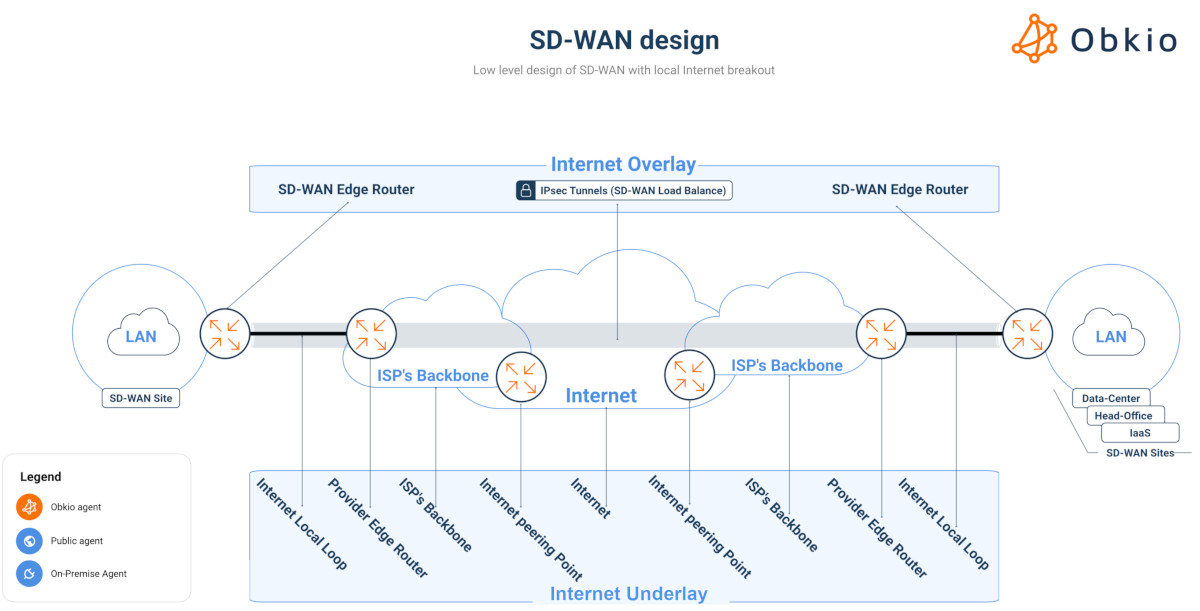
In the past, relying solely on failover mechanisms posed challenges, especially when both internet connections experienced simultaneous failures. This scenario left organizations vulnerable to downtime and potential disruptions, undermining the reliability of the dual-WAN setup. The traditional approach, while providing basic redundancy, lacked the agility needed to adapt to dynamic network conditions.
SD-WAN introduces a more advanced and productive approach to managing dual-WAN networks, addressing the limitations of traditional failover mechanisms. One of the key advantages is the ability to dynamically and intelligently route traffic across multiple WAN links based on real-time conditions. This goes beyond a simple failover scenario, offering a more nuanced and responsive strategy for handling network disruptions.
Dynamic Path Selection:
SD-WAN solutions can dynamically select the optimal path for traffic based on factors such as latency, packet loss, and bandwidth availability. This ensures that traffic is routed through the most reliable and efficient connection at any given moment.
Application-Aware Routing:
SD-WAN is application-aware, allowing it to prioritize critical applications over less sensitive traffic. This ensures that essential services receive the necessary bandwidth and low latency or good latency, even during failover scenarios.
Policy-Based Routing:
Policies can be defined to dictate how different types of traffic should be handled. This granular control allows organizations to tailor routing decisions to their specific needs and priorities.
Automation and Orchestration:
SD-WAN solutions often incorporate automation and orchestration capabilities, allowing for quick adaptation to changing network conditions without manual intervention. This agility is crucial for maintaining connectivity and performance.
Integration with Firewalls:
A notable advantage is that many SD-WAN features are available directly on modern firewalls. This integration streamlines the implementation of advanced failover strategies without the need for additional specialized hardware or complex configurations.
In conclusion, SD-WAN represents a significant leap forward in managing dual-WAN networks. Its dynamic, application-aware, and centralized approach not only enhances failover capabilities but also provides organizations with the agility and intelligence needed to navigate the complexities of modern network environments. The same can be said for other services like SASE as well.
And if you’re looking to make the change to SD-WAN, we got you covered, because Obkio monitors SD-WAN networks too!
Learn how to monitor SD-WAN networks with Network Monitoring to get complete visibility over your SD-WAN service and identify SD-WAN issues.
Learn more

Monitoring, troubleshooting, and optimizing your Dual-WAN network is crucial for a seamless and reliable experience. Throughout our exploration, we've highlighted the pivotal role monitoring plays in not just understanding, but proactively managing these complex setups.
Monitoring Dual-WAN networks is essentially for businesses, offering real-time visibility into key performance metrics, link status, and potential issues. It serves as the compass guiding us through the nuances of Dual-WAN architecture, allowing us to detect and address problems before they impact operations.
Understanding the inevitability of failures underscores why monitoring is not merely a box to check but a continuous, proactive strategy. It's the key to recognizing patterns, optimizing load-balancing configurations, and ensuring that your Dual-WAN network operates at its peak.
As we wrap up this journey through monitoring, troubleshooting, and optimizing, one tool stands out to simplify and enhance your Dual-WAN experience – Obkio's Network Monitoring Tool.

Whether you're a seasoned IT pro or diving into the realm of Dual-WAN for the first time, Obkio offers a user-friendly solution designed to keep your network in peak condition. From real-time insights to proactive issue detection, Obkio ensures your Dual-WAN setup runs like a well-oiled machine.
Ready to take the next step in network mastery? Embrace the power of Obkio and elevate your Dual-WAN game today. Explore, optimize, and conquer with confidence!



























 Obkio Blog
Obkio Blog



